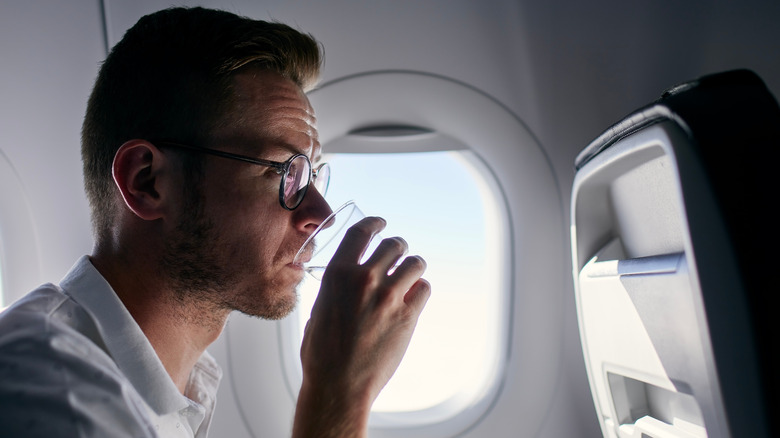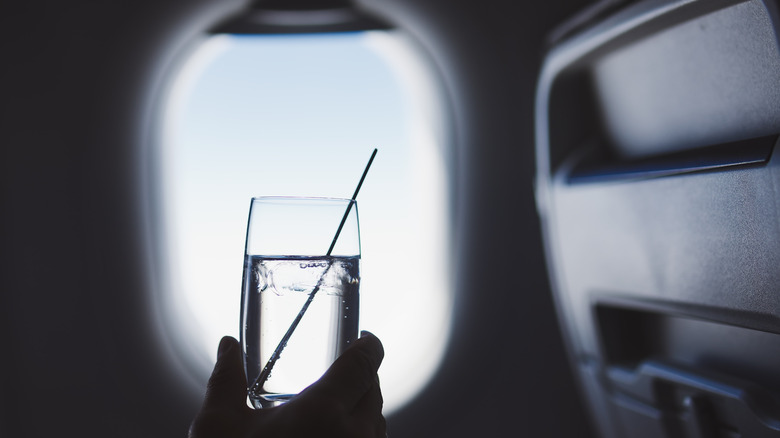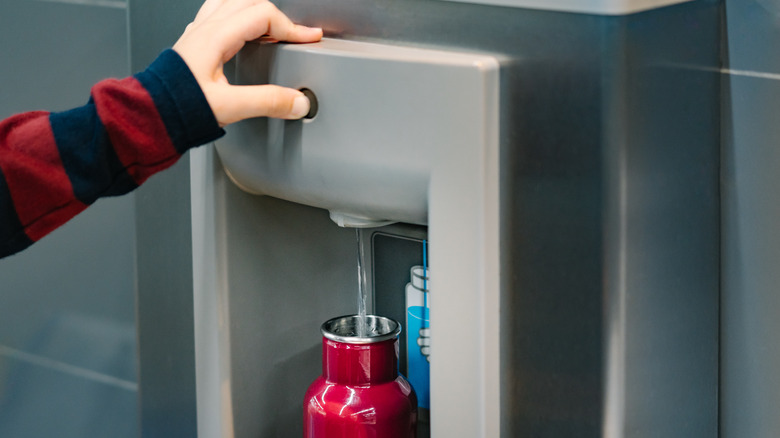Never Order Ice In Your Drink On A Plane. Here's Why
In this day and age, it might be hard to find someone who actually enjoys airplane food. That microwaved, soggy penne just doesn't hit the spot, so some passengers take it upon themselves to bring their own meals and snacks onboard for long or short-haul flights. That's right, you can bring your choice of food past security, as long as it's not a liquid (like soup), but when it comes to the liquids, you are usually forced to drink only the beverages served on your flight.
However, cabin crew and researchers agree that perhaps you should eschew the offer of ice in your drink when that beverage cart rolls up to your row. Redbook Magazine spoke with a flight attendant identifying as Max, who told the outlet, "Everytime I would pour ice, the bin had a wet, mildew smell." Max went on to say that the ice scoops are rarely cleaned, and the process of breaking up the ice into smaller bits could lead to contamination. So, should you be worried about serious stomach inflammation or sickness when it comes to airplane ice? Or can our tummies handle the excess bacteria? Let's take a closer look.
Studies found E.Coli in airplane water tanks
The mildew smell from the ice bin on the beverage cart isn't just a figment of Max's imagination, as according to a 2015 study from the International Journal of Environmental Research and Public Health, "aircraft water supply tanks are conducive for microbial growth." That said, when you pour your favorite drink over that plastic cup of ice, you are potentially contaminating your Diet Coke, tomato juice, or ginger ale with bacteria. The study also says that the water tanks on the plane are rarely sanitized or even emptied, which means even the coffee and tea are made with potentially bacteria-laden water. In fact, one flight attendant told Business Insider that they typically steer clear of water, coffee, and tea on flights. What's more, the EPA randomly tested the water supply on 158 planes in 2004 and discovered a whopping 20 tested positive for total coliform bacteria, and two even had E.coli.
Are these levels of bacteria life-threatening? Because no one wants to be the passenger running to the toilets every five minutes to void their bowels, that's for sure. Fortunately, the levels are tolerable. Katie Heil, seller/server learning experience design manager at Certus, told Readers Digest that, "Most healthy adults have strong enough immune systems to ingest them without consequences."
Bring your own drinks and ice on board
So what's a passenger to do if they have a queasy tummy, can't bring large bottles of liquid through security, and want to avoid the ice cubes, tap water, coffee, and tea on a flight at all costs? Well, there may be a rule against bringing your own water through security, but there's no rule against the water bottle. That's right: one of our fave airline travel hacks is to bring an empty water bottle (preferably reusable for a lesser impact on the environment) through security, and just fill it up at the next water fountain once you're past security. That way, you don't have to pay those costly airport prices for a water bottle and can stay hydrated.
Barring that, it's super easy to get liquids at the duty-free shops and restaurants in the airport terminal. If you need a hot or cold drink on your flight, run to Starbucks before you board. And if you really need ice on your flight, consider freezing the liquids you need to get on board. Because ice is a solid and not a liquid, you can pack it, as long as it stays solid for the time it takes you to get through that long security line. Fortunately, even the official TSA website approves porting your own ice so you never need to have airplane ice again.


